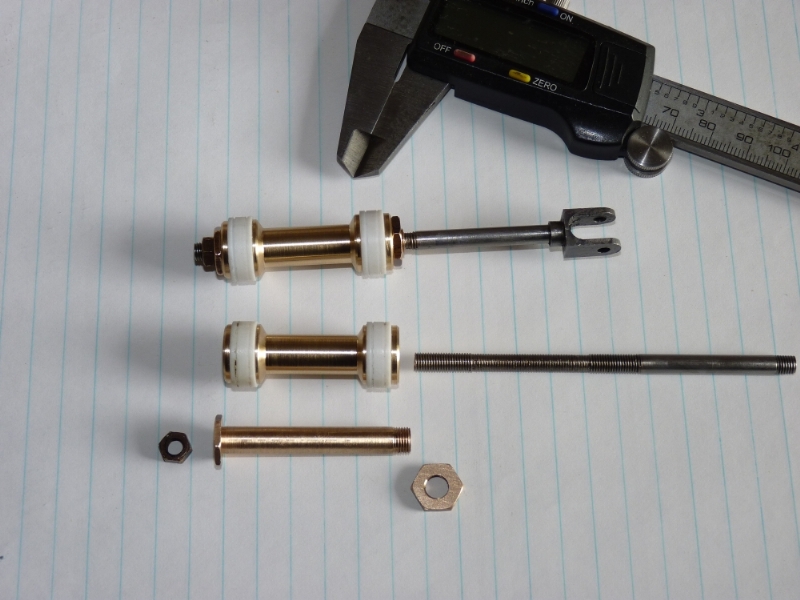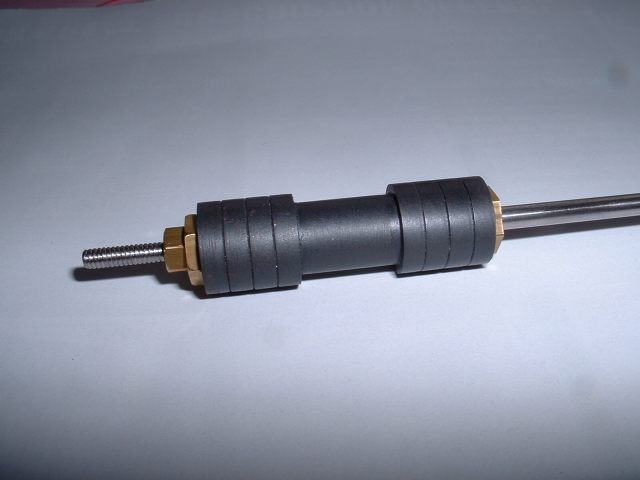|
|
Post by Roger on Jan 20, 2014 12:05:11 GMT
Thanks for making that clear Jim, that all makes sense now.
|
|
jma1009
Elder Statesman
  
Posts: 5,917
|
Post by jma1009 on Jan 20, 2014 12:36:38 GMT
it is worth reiterating the point about the edges of the PTFE sleeves having to be used as the valve measurements and for setting same.
in fullsize this caused a considerable problem with the SR SCHOOLS class until it was realised that the piston valves had to be measured from the rings on the type of piston valve these locos were fitted with. part of the solution was to relieve the heads as jim has done on his loco, but this doesnt provide as quick an opening to steam as part of the admission and exhaust as part of the port opening is restricted by the heads initially.
yet another factor that adds to the complications of using piston valves!
i suppose yet another factor is the tendancy of PTFE to 'flow' and alter it's shape, which could also affect the valve timing.
cheers,
julian
|
|
|
|
Post by Roger on Jan 20, 2014 13:40:47 GMT
Good points as always julian. I guess there's no reason why the piston flanges can't be chamfered almost to a sharp edge to help with the steam admission issue. So long as you're aware of the flange thickness I guess there should be no problem with using that as the reference and then adding the thickness to the setting measurement.
I guess in the end, it's a compromise between the efficacy of the seal versus any timing issues. As far as I can see, a solid metal bobbin is only going to get steadily more leaky over time whereas PTFE seals probably won't change significantly. Of course, if they do wear out, it's a lot easier to replace them too. I have to say that on balance, I'm convinced of the arguments for them.
|
|
|
|
Post by runner42 on Jan 20, 2014 21:01:12 GMT
Jim stated that on a 1" diameter bore a 0.003" clearance was required, can I assume that this scaled to be for a 5/8ths" diameter bore. the clearance would be 0.0015" to 0.002"?
Brian
|
|
jma1009
Elder Statesman
  
Posts: 5,917
|
Post by jma1009 on Jan 20, 2014 21:37:14 GMT
hi brian,
a 'push fit' for PTFE isnt 3 thou clearance in my book - that's a rattling good fit. PTFE will 'flow' and form to a bore size when hot and moved, and will form its own appropriate seal dia when hot.
cheers,
julian (NOT justin!)
|
|
|
|
Post by runner42 on Jan 20, 2014 21:50:20 GMT
Julian, sorry for the incorrect name, post edited.
Brian
|
|
jma1009
Elder Statesman
  
Posts: 5,917
|
Post by jma1009 on Jan 20, 2014 21:59:57 GMT
no probs, brian!
it is absolutely essential with PTFE to remove any sharp edges of burrs on the ports in the liners with PTFE piston valves. it is after all quite a soft material.
m-machine metals at darlington have 1" dia fluorosint in stock at the moment. expensive but generally considered far superior to ordinary PTFE, and what price ensuring piston valves dont blow in the overall cost of a miniature loco?
(fluoroscint is usually very difficult to obtain unless you are in an industry that uses same)
cheers,
julian
|
|
|
|
Post by Jim on Jan 20, 2014 22:33:27 GMT
Sorry Brian but I think you've misread the post, easily done I know, as I do it all the time. It's the wall thickness that is no more than .093" for a 1" bore and that can be scaled accordingly for bore sizes. The .003" clearance is on the diameter of the bobbin over which the PTFE ring slips and is to allow for expansion inwards while maintaining a perfect seal against the bore. Personally I'd leave that as it is.
Jim
|
|
jma1009
Elder Statesman
  
Posts: 5,917
|
Post by jma1009 on Jan 20, 2014 22:49:26 GMT
hi jim,
im so pleased you clarified that! i was sure you hadnt made a mistake on the PTFE dia!
cheers,
julian
|
|
|
|
Post by runner42 on Jan 21, 2014 1:17:23 GMT
Hi Jim,
I assumed that the bobbin included the PTFE inserts, but having read your clarification I see that you meant the bobbin as being the metal body only. The piston valve (bobbin + PTFE inserts) are going to expand and the 0.003" clearance between the bobbin and PTFE inserts will provide space for the expansion to take place and prevent seizing. I would imagine that the 0.003" would be desireable if not essential. I assume you included this clearance?
Brian
|
|
|
|
Post by Jim on Jan 21, 2014 6:43:45 GMT
You're correct Brian, I certainly included the .003" clearance.
Jim
|
|
Midland
Elder Statesman
  
Posts: 1,875
|
Post by Midland on Jul 11, 2017 19:29:56 GMT
hi jim, im so pleased you clarified that! i was sure you hadnt made a mistake on the PTFE dia! cheers, julian Julian This last bit confuseed me but the rest is a most informative discussion. But rather than talking about tiny dimensions let me ask you what I should do. Piston valve bore is .752, Bobbin is .750, groove deprth for the rings in the bobbin is .049 for an id of .652. So should I make ptfe rings at .752 or allow the .003 per inch and call it .002 for 3/4s of that? So the end result is back to .750. Cast iron bores I think, certainly, magnetic although they might have a liner!!!! Thanks David |
|
jma1009
Elder Statesman
  
Posts: 5,917
|
Post by jma1009 on Jul 11, 2017 21:42:55 GMT
Hi David,
If the piston valve liners are cast iron then use proper piston rings not PTFE.
Cheers,
Julian
|
|
Midland
Elder Statesman
  
Posts: 1,875
|
Post by Midland on Jul 12, 2017 13:17:03 GMT
Ta Julian, seem to be getting somewhere, see my MR990 thread.
David
|
|
hibrow
Member
 Hi need to make a rotating system for my king any body got any plans photos etc
Hi need to make a rotating system for my king any body got any plans photos etc
Posts: 4 
|
Post by hibrow on Feb 26, 2018 8:38:42 GMT
Brian - the piston valve saga is documented in the Helen Longish section with all the trials and tribulations! I also made a set of PTFE headed valves for a friend at the club that were very successful. Piston Valves One thing I have found is that although the valves seal perfectly under steam they will leak when cold e.g. if you want to run the loco on air again - They shrink when they cool down after the first steaming. You could possibly reduce this shrinking on cooling effect by making the PTFE heads as thin as possible. Those on Helen Longish are only 0.0625" thick.When you initially machine the heads you just make them a push fit into the liner and they sort themselves out when they get hot. I tried various ideas for the valves for Helen including the Don Young method of knocking the valve back and forth using MDS as a lubricant and this did work well. Unfortunately, I did use stainless for the bobbins this time and they did score badly as Julian mentions. Roger - I've tried the solid bobbin method with Helen using bearing grade PEEK and gave up on it in the end. To get a running fit at working temperature the bobbins had to be a really sloppy fit when cold. I did have two things against me though - the piston valves are made to the double ported Greenly type and the valve heads are very long which increased the area of contact between the head and the liner and made them more prone to seizing. Also the level of superheat on Helen is very high which increases the working temperature of the cylinders to over 200°C which made the expansion problem much worse. You could try using Fluorosint (Mica filled PTFE) which has an expansion similar to bronze. Jim Ewins used this but it's very expensive!  ![]() Original solid valves: ![]()  New PTFE version in present use and still perfectly steam tight after 5 years use:  |
|
hibrow
Member
 Hi need to make a rotating system for my king any body got any plans photos etc
Hi need to make a rotating system for my king any body got any plans photos etc
Posts: 4 
|
Post by hibrow on Feb 26, 2018 8:42:42 GMT
Brian - the piston valve saga is documented in the Helen Longish section with all the trials and tribulations! I also made a set of PTFE headed valves for a friend at the club that were very successful. Piston Valves One thing I have found is that although the valves seal perfectly under steam they will leak when cold e.g. if you want to run the loco on air again - They shrink when they cool down after the first steaming. You could possibly reduce this shrinking on cooling effect by making the PTFE heads as thin as possible. Those on Helen Longish are only 0.0625" thick.When you initially machine the heads you just make them a push fit into the liner and they sort themselves out when they get hot. I tried various ideas for the valves for Helen including the Don Young method of knocking the valve back and forth using MDS as a lubricant and this did work well. Unfortunately, I did use stainless for the bobbins this time and they did score badly as Julian mentions. Roger - I've tried the solid bobbin method with Helen using bearing grade PEEK and gave up on it in the end. To get a running fit at working temperature the bobbins had to be a really sloppy fit when cold. I did have two things against me though - the piston valves are made to the double ported Greenly type and the valve heads are very long which increased the area of contact between the head and the liner and made them more prone to seizing. Also the level of superheat on Helen is very high which increases the working temperature of the cylinders to over 200°C which made the expansion problem much worse. You could try using Fluorosint (Mica filled PTFE) which has an expansion similar to bronze. Jim Ewins used this but it's very expensive!  ![]() Original solid valves: ![]()  New PTFE version in present use and still perfectly steam tight after 5 years use:  hi john made some ptfe rings for the valve what would you call a good safe fit when inserted ito the valve boar |
|